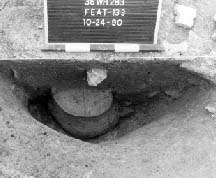 A Prehistoric Food
Crisis in Washington County
A Prehistoric Food
Crisis in Washington County A Prehistoric Food
Crisis in Washington County
A Prehistoric Food
Crisis in Washington CountyThe picture was alarming: Native Americans inhabiting eastern North America in the 13th and 14th centuries combatted the "Little Ice Age," overpopulation and a drain on natural resources—producing hard times that scientists are only recently discovering.
In 1989–91, archaeologists from Carnegie Museum of Natural History excavated a site in Washington County, Pennsylvania, finding that as a result of these stresses the people living there suffered from very poor nutrition.
Some scholars suggest that the Native American population in North America was at its peak just before 1200–1300 and that this period of hardship was the beginning of a decline that accelerated in the 16th century with the influx of Europeans with alien diseases.
The archaeological site that yielded our information is located less than a mile south of Ladbroke at the Meadows Race Track in Washington County, on the former Wylie Farm. The site is on a bench overlooking an unnamed stream that leads to a tributary of Chartiers Creek. Its proximity to major highways and population centers generated public interest in excavating it before it fell victim to development as did much of the Wylie property. Members of the Allegheny chapter of the Society for Pennsylvania Archaeology joined museum scientists in excavating the site, which was bisected by road construction in the 19th century.
Artifacts collected from the surface were mostly of Late Prehistoric-Monongahela origin and were donated to Carnegie Museum of Natural History by the landowners. Radiocarbon dating and settlement pattern analysis of these items indicated that the site was occupied four times during the Late Prehistoric Period, ca. 900–1600. The two most prominent of these occupations occurred around 1170 and again around 1330.
A map of the site shows the villages with round houses and protective stockades, but the houses of the later village are somewhat smaller. There is one other significant difference: Within some of the subsurface pits of the 1330 village were found the diminutive shells of the Shawnee Rocksnail, Lithasic obovata pennsylvanica. I believe that these shells represent the remains of a very poor source of nutrition for a desperate people! A similar situation was hypothesized for an earlier site in central Tennessee, where freshwater gastropods—a poor source of nutrition—may have been boiled to produce a broth or stock.
The relative paucity of charred plant material, whether wild or domesticated, is more evidence that the site occupants were under stress. Maize, a higher quality source of nutrition, was found in only 34 percent of these pits, compared with 50 percent or more on three other Monongahela sites that we studied. These three other sites were occupied at different, and probably more prosperous, times than the Wylie site.
Based on our recommendations, The Archaeological Conservancy—a national organization that buys archaeological sites and preserves them as cultural resources—purchased three other Monongahela sites on the Wylie Farm in 1995. The Wylie site that we excavated was not included in the transaction because it had already been impacted by road construction and the excavations. As of August 1997, all of the remaining land on the Wylie Farm is under development.
There are now very few large-scale excavations of prehistoric villages taking place in eastern North America. Thus, we are anxious to return to the site in the near future to complete the excavation. We want to get a "big-picture view" of the entire village, and we also hope to find evidence of the types of houses built by later populations. Finishing the Wylie site will add to an important database provided by archaeologists at Carnegie Museum of Natural History. We hope that we can get back to the site before it falls victim to development and disappears, as did the people who once lived there.
Richard L. George is a field archaeologist at Carnegie Museum of
Natural History.